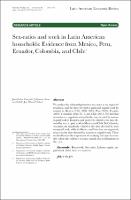| dc.creator | Campaña, Juan Carlos |
| dc.creator | Gimenez-Nadal, J. Ignacio |
| dc.creator | Molina, Jose Alberto |
| dc.date.issued | 2021-06-18 |
| dc.identifier.issn | 2196-436X |
| dc.identifier.uri | http://hdl.handle.net/11651/4763 |
| dc.description | Household, sex-ratios, labour supply, unpaid work, Latin America countries |
| dc.description.abstract | We analyze the relationship between sex-ratios in the region of residence, and the time devoted to paid and unpaid work by couples in Mexico (2002, 2009, 2014), Peru (2010), Ecuador (2012), Colombia (2012, 2017) and Chile (2015). We find that sex-ratios are negatively related to the time devoted by women to paid work in Ecuador, and positively related to the time devoted by men to paid work in Mexico and Chile. In Colombia, sex-ratios are negatively related to the time devoted by men to unpaid work, while in Mexico and Peru they are negatively related to the time devoted by women to unpaid work. These results illustrate the importance of studying this topic in countries where the evidence is scarce, mainly due to limitations in the data. |
| dc.format | application/PDF |
| dc.language.iso | eng |
| dc.publisher | Centro de Investigación y Docencia Económicas |
| dc.relation.ispartof | Latin American Economic Review, volumen 30, número 1, junio de 2021 |
| dc.rights | La revista Latin American Economic Review autoriza a poner en acceso abierto de conformidad con las licencias CREATIVE COMMONS, aprobadas por el Consejo Académico Administrativo del CIDE, las cuales establecen los parámetros de difusión de las obras con fines no comerciales. Lo anterior sin perjuicio de los derechos morales que corresponden a los autores. |
| dc.source | 2196-436X |
| dc.title | Sex-ratios and work in Latin American households: evidence from Mexico, Peru, Ecuador, Colombia, and Chile |
| dc.type | Artículo |
| dc.accessrights | Acceso abierto |
| dc.recordIdentifier | 000004763 |
| dc.rights.license | Creative Commons Reconocimiento-NoComercial-SinObraDerivada 4.0 International CC BY-NC-ND |
| dc.relation.project | “Spanish Ministry of Economics” |
| dc.relation.project | “European Social Fund” |
| dc.identifier.citation | En: Latin American Economic Review, volumen 30, número 1, junio de 2021 |
| dc.identifier.doi | https://doi.org/10.47872/laer-2021-30-3 |
| dc.relation.dataset | http://repositorio.cepal.org/bitstream/11362/37626/5/anexo_estadistico2014_es.zip |
| dc.relation.dataset | http://microdatos.dane.gov.co/index.php/catalog/214/study-description |
| dc.relation.dataset | https://www.dane.gov.co/index.php/estadisticas-por-tema/pobreza-y-condiciones-de-vida/encuesta-nacional-del-uso-del-tiempo-enut |
| dc.relation.dataset | http://www.ine.cl/docs/default-source/proyecciones-de-poblacion/cuadros-estadisticos/base-2017/ine_estimaciones-y-proyecciones-2002-2035_base-2017_region_area_tabulados.xlsx?sfvrsn=e9bd6edf_6 |
| dc.relation.dataset | https://www.inegi.org.mx/programas/enut/2002/ |
| dc.relation.dataset | https://www.inegi.org.mx/rnm/index.php/catalog/12 |
| dc.relation.dataset | https://www.inegi.org.mx/programas/enut/2014/ |
| dc.relation.dataset | https://www.inegi.org.mx/programas/ccpv/2000/ |
| dc.relation.dataset | http://censos.inei.gob.pe/cpv2007/tabulados/ |
| dc.relation.dataset | https://data.worldbank.org/indicator/SL.TLF.CACT.FE.ZS |
| dc.identifier.url | https://ojs.latinaer.org/laer/article/view/18 |


